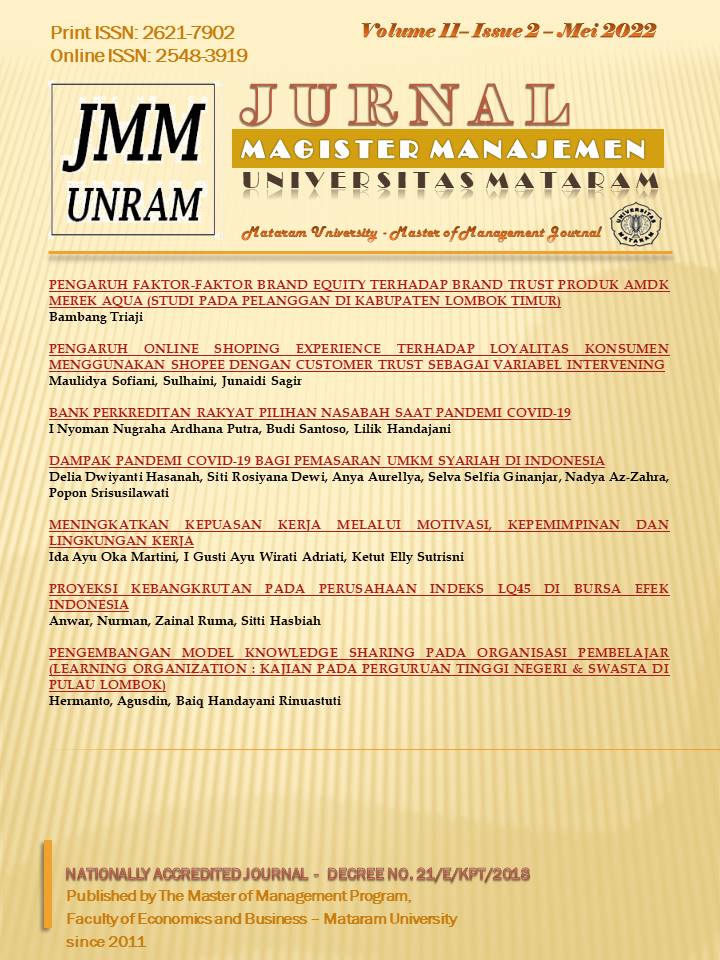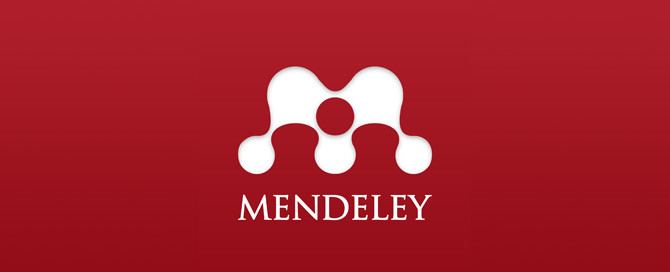PENGARUH FAKTOR-FAKTOR BRAND EQUITY TERHADAP BRAND TRUST PRODUK AMDK MEREK AQUA (STUDI PADA PELANGGAN DI KABUPATEN LOMBOK TIMUR).
DOI:
https://doi.org/10.29303/jmm.v11i2.698Abstract
The aims of this reasearch are to know how the dimesions of brand equity which consists of brand awareness, brand associations, perceived quality and brand loyalty have partially and simultaneously influences with brand trust for AQUA mineral water customer’s in Kabupaten Lombok Timur. Data collections was carried out with interviews and questionnaires and sampling method in this research use non probabilty sampling-purpose sampling methods. The number of samples are 95 customers who always buy AQUA mineral water in Kabupaten Lombok Timur. Data analysis was performed using simple linear regression and multiple linear regression. The results in this research shows that the dimensions of brand equity (brand awareness, brand associations, perceived quality and brand loyalty) partially and simultaneously have some significant influences with brand trust.References
Aaker, D.A. (2013). Manajemen Pemasaran Strategis. Jakarta : Salemba Empat.
................... (2018). Manajemen Ekuitas Merek. Jakarta : Mitra Utama.
Aaker, D.A. Kumar V. Leone R.P. Day G.S. (2013). Marketing Research. Eleventh Edition. New Jersey : John Wiley & Son Inc.
Batra, R., Ahuvia, A. and Bagozzi, R.P. (2012), “Brand love”, Journal of Marketing, Vol. 76 No. 1, pp. 1-16.
Biedenbach, G., Hulten, P. (2019). B2B Brand Equity: Investigating the Effects of Human Capital and Relational Trust. Journal of Business & Industrial Marketing 34/1 (2019) 1–11.
Darmadi. D. Sugiarto dan Sitinjak T. (2017). Strategi Menaklukan Pasar Melalui Riset Ekuitas Dan Perilaku Merek. Jakarta : Gramedia Pustaka Utama.
Das, G. (2016). Antecedents and consequences of trust: An e-tail branding perspective. International Journal of Retail & Distribution Management, 44(7), 713–730. https://doi.org/10.1108/IJRDM-06-2015-0089
Erciş, A., Ünal, S., Candan, F. B., & Yıldırım, H. (2012). The Effect of Brand Satisfaction, Trust and Brand Commitment on Loyalty and Repurchase Intentions. Procedia - Social and Behavioral Sciences, 58, 1395–1404. https://doi.org/10.1016/j.sbspro.2012.09.1124
Frontier. (2021). Top Brand Index Kategori Air Minum Dalam Kemasan. https://www.topbrand-award.com/en/top-brand-index-int/?tbi_find=aqua. Diakses pada 24 Novermber 2021.
Huang, C. C. (2017). The Impacts of Brand Experiences on Brand Loyalty: Mediators of Brand Love and Trust, Management Decision, Vol. 55, Issue 5, pp.915-934.
Hur, W., Ahn, K., & Kim, M. (2011). Building brand loyalty through managing brand community commitment. Management Decision, 49(7), 1194–1213. https://doi.org/10.1108/00251741111151217
Kaushal, V., & Ali, N. (2020). University Reputation, Brand Attachment and Brand Personality as Antecedents of Student Loyalty: A Study in Higher Education Context. Corporate Reputation Review, 23(4), 254–266. https://doi.org/10.1057/s41299-019-00084-y
Keller, K.L. (2013), Strategic Brand Management: Building, Measuring, and Managing Brand Equity, 4th ed., Prentice-Hall, Upper Saddle River, New Jersey, NJ.
Kotler, P., & Keller, K. L. (2016). Marketing management (15 [edition]). Pearson.
Kumar, R.S., Dash, S. and Purwar, P.C. (2013), “The nature and antecedents of brand equity and its dimensions”, Journal of Marketing Intelligence and Planning, Vol. 31 No. 2, pp. 141-159.
Lin, M. Q. and Lee, B. C. (2012), “The Influence of Website Environment on Brand Loyalty: Brand Trust and Brand Affect as Mediators”, International Journal of Electronic Business Management, Vol. 10, No. 4, pp. 308-321.
Mediatama, G. (2021, April 11). Industri AMDK optimistis catatkan pertumbuhan penjualan hingga 5% di tahun ini. www.kontan.co.id. https://amp.kontan.co.id/news/Industri.kontan.co.id/news/industri-amdk-optimistis-catatkan-pertumbuhan-penjualan-hingga-5-di-tahun-ini
Mishra, A., Dash, S. B., & Cyr, D. (2014). Linking user experience and consumer-based brand equity: The moderating role of consumer expertise and lifestyle: Journal of Product & Brand Management, 23(4/5), 333–348. https://doi.org/10.1108/JPBM-12-2013-0459
Munuera-Aleman, J. L., Delgado-Ballester, E., & Yague-Guillen, M. J. (2003). Development and Validation of a Brand Trust Scale. International Journal of Market Research, 45(1), 1–18. https://doi.org/10.1177/147078530304500103
Pinar, M., Girard, T., & Basfirinci, C. (2020). Examining the relationship between brand equity dimensions and university brand equity: An empirical study in Turkey. International Journal of Educational Management, 34(7), 1119–1141. https://doi.org/10.1108/IJEM-08-2019-0313
Raut, U.R. and Brito, P.Q. (2014), “An analysis of Brand relationship with the perceptive of customer based Brand equity pyramid”, Working Papers (FEP), University of Porto, Vol. 526, pp. 1-17.
Sekaran, U., Bougie, R. (2017). Metode Penelitian Untuk Bisnis : Pendekatan Pengembangan Keahlian. Edisi 6. Buku 1. Cetakan Kedua. Jakarta Selatan : Salemba Empat.
Sharma, R., & Jain, V. (2019). CSR, Trust, Brand Loyalty and Brand Equity: Empirical Evidences from Sportswear Industry in the NCR Region of India. Metamorphosis: A Journal of Management Research, 18(1), 57–67. https://doi.org/10.1177/0972622519853158
Singla, V., & Gupta, G. (2019). Emotional Branding Scale and Its Role in Formation of Brand Trust. Paradigm, 23(2), 148–163. https://doi.org/10.1177/0971890719859668
Sugiyono. (2014). Metode Penelitian Kuantitatif, Kualitatif dan R&D. Edisi Pertama. Bandung : Alfabeta
Downloads
Published
How to Cite
Issue
Section
License
Copyright (c) 2022 Bambang SE.MM.

This work is licensed under a Creative Commons Attribution 4.0 International License.
- Authors retain copyright and grant the journal right of first publication with the work simultaneously licensed under a CC BY 4.0. This license allows authors to use all articles, data sets, graphics, and appendices in data mining applications, search engines, web sites, blogs, and other platforms by providing an appropriate reference. The journal allows the author(s) to hold the copyright without restrictions and will retain publishing rights without restrictions.
- Authors are able to enter into separate, additional contractual arrangements for the non-exclusive distribution of the journal's published version of the work (e.g., post it to an institutional repository or publish it in a book), with an acknowledgment of its initial publication in JMM.
- Authors are permitted and encouraged to post their work online (e.g., in institutional repositories or on their website) prior to and during the submission process, as it can lead to productive exchanges, as well as earlier and greater citation of published work (See The Effect of Open Access).










